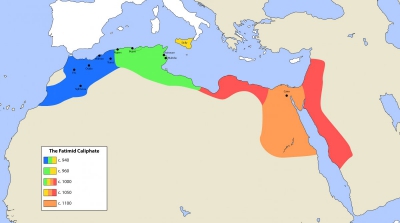The Battle of the Orontes was fought on 15 September 994 between the Byzantines and their Hamdanid allies under Michael Bourtzes against the forces of the Fatimid vizier of Damascus, the Turkish general Manjutakin. The battle was a Fatimid victory.
The Fatimid Caliphate (Arabic: الخلافة الفاطمية, romanized: al-Khilāfa al-Fāṭimiyya) was an Ismaili Shia caliphate of the 10th to the 12th centuries AD. Spanning a large area of North Africa, it ranged from the Red Sea in the east to the Atlantic Ocean in the west. The Fatimids, a dynasty of Arab origin, trace their ancestry to Muhammad's daughter Fatima and her husband ‘Ali b. Abi Talib, the first Shi‘ite imam. The Fatimids were acknowledged as the rightful imams by different Isma‘ili communities, but also in many other Muslim lands, including Persia and the adjacent regions. Originating during the Abbasid Caliphate, the Fatimids conquered Tunisia and established the city of "al-Mahdiyya" (Arabic: المهدية). The Shiʿite dynasty ruled territories across the Mediterranean coast of Africa and ultimately made Egypt the center of the caliphate. At its height, the caliphate included – in addition to Egypt – varying areas of the Maghreb, Sudan, Sicily, the Levant, and the Hijaz.
Between 902 to 909 the foundation of the Fatimid state was realized by the Kutama Berbers, under the leadership of the da'i (missionary) Abu Abdallah, whose conquest of Ifriqiya paved the way for the establishment of the Caliphate. After this conquest, Abdullāh al-Mahdī Billa was retrieved from Sijilmasa and then accepted as the Imam of the movement, becoming the first Caliph and founder of the ruling dynasty in 909. In 921, the city of al-Mahdiyya was established as the capital. In 948, they shifted their capital to al-Mansuriyya, near Kairouan. In 969, during the reign of al-Mu'izz, they conquered Egypt, and in 973 the caliphate was moved to the new capital of Cairo. Egypt became the political, cultural, and religious centre of their empire, which developed a new and "indigenous Arabic" culture. After its initial conquests, the caliphate often allowed a degree of religious tolerance towards non-Shia sects of Islam, as well as to Jews and Christians. However, its leaders made little headway in persuading the Egyptian population to adopt its religious beliefs.After the reigns of al-'Aziz and al-Hakim, the long reign of al-Mustansir entrenched a regime in which the caliph remained aloof from state affairs and viziers took on greater importance. Political and ethnic factionalism within the army led to a civil war in the 1060s which threatened the empire's survival. After a period of revival during the tenure of the vizier Badr al-Jamali (d. 1094), the Fatimid caliphate declined rapidly during the late eleventh and twelfth centuries. In addition to internal difficulties, the caliphate was weakened by the encroachment of the Seljuk Turks into Syria in the 1070s and the arrival of the Crusaders in the Levant after 1098. In 1171, Saladin abolished the dynasty's rule and founded the Ayyubid dynasty, which incorporated Egypt into the nominal sphere of authority of the Abbasid Caliphate.

 English
English  español
español  français
français  português
português  русский
русский  العربية
العربية  简体中文
简体中文 
